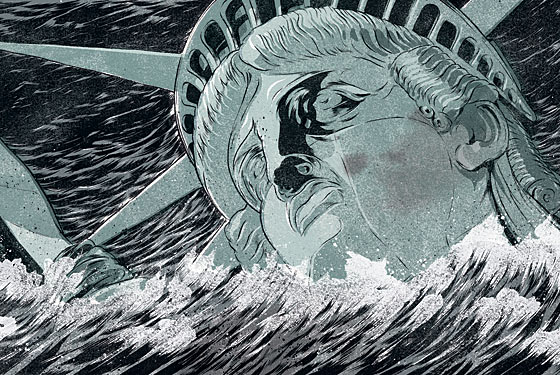
In the same week that Japan was coping with waterborne calamity, Mayor Bloomberg announced a ten-year plan to make New York’s waterfront busier, greener, and more fun. It may seem grotesque to cheer a crop of new kayak launches when we’re worrying about flooded reactors and watching videos of cars shooting urban rapids in Miyagi. But in fact, the city’s comprehensive waterfront plan couldn’t be timelier.
After decades in which New Yorkers saw the Hudson River estuary as an obstacle or an abstraction, we’ve finally begun to recognize both the privileges and the threats of being surrounded by water. It used to be easy to forget that New York is a maritime city. A DMZ of dilapidated warehouses, roadways, and wire fences once cut us off from the intricate arrangement of bays, canals, creeks, marshes, and rivers.
Reclaiming the waterfront is the great urban project of our time, not just here but all over the world. Until half a century ago, the city’s edge teemed with freighters and stevedores. Then a truck-company owner named Malcolm McLean realized that goods packed into huge metal boxes could be easily hoisted from train to truck to boat. Containerization, which required fewer workers and more upland acres, killed the congested downtown port. As a result, every harbor city from Hong Kong to Hamburg has had to figure out how to recycle a derelict urban shoreline.
The transformation of New York’s edge began years ago, and its denizens are now a varied and growing population of pleasure boaters, garbage haulers, anglers, environmentalists, Coast Guard officers, and coastal dwellers. But the lure of the water also forces us to confront a different amphibious future, in which the seas advance toward us.
An East Coast tsunami is highly unlikely, but climatologists predict with greater confidence that in the coming decades, the oceans will rise and ever more ferocious storms will pummel us. One way to deal with that prospect might be to pull the city back from the seas. But it’s too late for that, and probably always was. Retreat would mean relocating Kennedy airport, shrinking Manhattan, evacuating Long Island City, and abandoning subway tunnels. New York would have to deny its geography and turn its back on the harbor that made it flourish in the first place.
The Bloomberg plan does the opposite: It envisions a city necklaced in shoreline parks, recommitted to shipping, and swarming with ferries. The plan’s ten-year wish list comes bundled with 130 short-term, largely mundane goals (planting 3,000 eelgrass plants at Breezy Point Tip in Queens, for example), but when it comes to holding back hurricanes, the details dissipate into a haze of studies, hopes, and good intentions. There are reasons for this sudden onset of vagueness. Visionaries and planners have floated ideas for encircling the city with grassy sponges, oyster reefs, and apartment buildings that bob like buoys, but the truth is that nobody really knows how to protect a major metropolis from the future.
So for now we must make do with the concept of climate resilience—the idea that if we can’t remain dry in the face of a liquid onslaught, we can blunt the worst blows, minimize the damage, and recover quickly. The traditional line of defense is the concrete bulkhead: a sheer wall of the kind that surrounds Battery Park City—and that Hurricane Katrina and the Japanese tsunami so handily overwhelmed. Current wisdom puts its tenuous faith in “soft edges,†bands of rubble, marsh, dunes, piers, and vegetation that allow high water to flow in but also slow it down, absorb it, and then let it rapidly drain. The beauty of this jujitsu approach is that reaching toward the water and preparing for its attack amount to the same thing. Take a look at the still-evolving Brooklyn Bridge Park, with its grassy slope, salt marsh, wetlands, granite steps, and piled stones: These are not just Âleisure-time luxuries. They’re elements in a regional system that won’t repel the oceans but might at least pacify the flood next time.
Have good intel? Send tips to intel@nymag.com.
